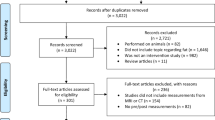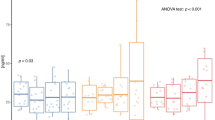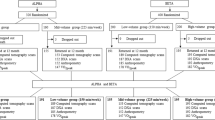Abstract
Background/Objectives
To test the effects of weight loss with and without exercise training (aerobic or resistance) on intra-abdominal adipose tissue (IAAT) and risk factors for cardiovascular disease (CVD). Additionally, CVD risk factors was evaluated before and after weight loss using previously established IAAT cut-points.
Subjects/Methods
One hundred twenty-two overweight premenopausal women were randomly assigned to one of three groups: (1) diet only (Diet); (2) diet and aerobic training (Diet + AT); or (3) diet and resistance training (Diet + RT); until a BMI of < 25 kg/m2 was reached. Computerized tomography was used to measure IAAT and blood lipids were measured by assay. Evaluations were made before and after weight loss.
Results
Though no group-by-time effects were found after weight loss, we observed significant time effects for: IAAT (−38.0%, P < 0.001), total cholesterol (TC) (−2.2%, P = 0.008), low-density lipoprotein cholesterol (LDL-C) (−4.8%, P < 0.001), high-density lipoprotein cholesterol (HDL-C) (+20.2%, P < 0.001), triglycerides (−18.7%, P < 0.001), TC/HDL-C (−16.3%, P < 0.001), and LDL-C/HDL-C (−18.0%, P < 0.001). Following weight loss, 40.2% of all participants reduced IAAT to < 40 cm2 (IAAT associated with low CVD risk). Furthermore, only 2.5% of participants had an IAAT > 110 cm2 (IAAT associated with high CVD risk) after weight loss. We also observed that decreases of IAAT were associated with decreased CVD risk factors after weight loss independent of race, changes in %fat mass and changes in maximal oxygen uptake.
Conclusions
Caloric restriction leading to significant weight loss with or without exercise training appears to be equally effective for reducing IAAT and CVD risk factors.
This is a preview of subscription content, access via your institution
Access options
Subscribe to this journal
Receive 12 print issues and online access
$259.00 per year
only $21.58 per issue
Buy this article
- Purchase on Springer Link
- Instant access to full article PDF
Prices may be subject to local taxes which are calculated during checkout

Similar content being viewed by others
References
Tchernof A, Després J-P. Pathophysiology of human visceral obesity: an update. Physiol Rev. 2013;93:359–404.
Williams MJ, Hunter GR, Kekes-Szabo T, Snyder S, Treuth MS. Regional fat distribution in women and risk of cardiovascular disease. Am J Clin Nutr. 1997;65:855–60.
Hunter GR, Kekes-Szabo T, Snyder SW, Nicholson C, Nyikos I, Berland L. Fat distribution, physical activity, and cardiovascular risk factors. Med Sci Sports Exerc. 1997;29:362–9.
Liu J, Fox CS, Hickson DA, May WD, Hairston KG, Carr JJ, et al. Impact of abdominal visceral and subcutaneous adipose tissue on cardiometabolic risk factors: the Jackson Heart Study. J Clin Endocrinol Metab. 2010;95:5419–26.
Elffers TW, de Mutsert R, Lamb HJ, de Roos A, Willems van Dijk K, Rosendaal FR. et al. Body fat distribution, in particular visceral fat, is associated with cardiometabolic risk factors in obese women. PLoS ONE. 2017;12:e0185403
Demerath EW, Reed D, Rogers N, Sun SS, Lee M, Choh AC, et al. Visceral adiposity and its anatomical distribution as predictors of the metabolic syndrome and cardiometabolic risk factor levels. Am J Clin Nutr. 2008;88:1263–71.
Ross R, Dagnone D, Jones PJ, Smith H, Paddags A, Hudson R, et al. Reduction in obesity and related comorbid conditions after diet-induced weight loss or exercise-induced weight loss in men. A randomized, controlled trial. Ann Intern Med. 2000;133:92–103.
Ross R. Effects of diet- and exercise-induced weight loss on visceral adipose tissue in men and women. Sports Med. 1997;24:55–64.
Janssen I, Ross R. Effects of sex on the change in visceral, subcutaneous adipose tissue and skeletal muscle in response to weight loss. Int J Obes Relat Metab Disord. 1999;23:1035–46.
Janssen I, Fortier A, Hudson R, Ross R. Effects of an energy-restrictive diet with or without exercise on abdominal fat, intermuscular fat, and metabolic risk factors in obese women. Diabetes Care. 2002;25:431–8.
Idoate F, Ibañez J, Gorostiaga EM, García-Unciti M, Martínez-Labari C, Izquierdo M. Weight-loss diet alone or combined with resistance training induces different regional visceral fat changes in obese women. Int J Obes 2005. 2011;35:700–13.
Kohrt WM, Obert KA, Holloszy JO. Exercise training improves fat distribution patterns in 60- to 70-year-old men and women. J Gerontol. 1992;47:M99–105.
Schwartz RS, Shuman WP, Larson V, Cain KC, Fellingham GW, Beard JC, et al. The effect of intensive endurance exercise training on body fat distribution in young and older men. Metabolism. 1991;40:545–51.
Carnero EA, Amati F, Pinto RS, Valamatos MJ, Mil-Homens P, Sardinha LB. Regional fat mobilization and training type on sedentary, premenopausal overweight and obese women. Obesity. 2014;22:86–93.
Ho SS, Dhaliwal SS, Hills AP, Pal S. The effect of 12 weeks of aerobic, resistance or combination exercise training on cardiovascular risk factors in the overweight and obese in a randomized trial. BMC Public Health. 2012;12:704.
Després J-P, Lamarche B. Effects of diet and physical activity on adiposity and body fat distribution: implications for the prevention of cardiovascular disease. Nutr Res Rev. 1993;6:137–59.
Ross R, Rissanen J. Mobilization of visceral and subcutaneous adipose tissue in response to energy restriction and exercise. Am J Clin Nutr. 1994;60:695–703.
Keating SE, Machan EA, O’Connor HT, Gerofi JA, Sainsbury A, Caterson ID, et al. Continuous exercise but not high intensity interval training improves fat distribution in overweight adults. J Obes. 2014;2014:834865.
Hunter GR, Bryan DR, Wetzstein CJ, Zuckerman PA, Bamman MM. Resistance training and intra-abdominal adipose tissue in older men and women. Med Sci Sports Exerc. 2002;34:1023–8.
Treuth MS, Hunter GR, Kekes-Szabo T, Weinsier RL, Goran MI, Berland L. Reduction in intra-abdominal adipose tissue after strength training in older women. J Appl Physiol. 1995;78:1425–31.
Williams MJ, Hunter GR, Kekes-Szabo T, Trueth MS, Snyder S, Berland L, et al. Intra-abdominal adipose tissue cut-points related to elevated cardiovascular risk in women. Int J Obes Relat Metab Disord. 1996;20:613–7.
Kvist H, Chowdhury B, Grangård U, Tylén U, Sjöström L. Total and visceral adipose-tissue volumes derived from measurements with computed tomography in adult men and women: predictive equations. Am J Clin Nutr. 1988;48:1351–61.
Friedewald WT, Levy RI, Fredrickson DS. Estimation of the concentration of low-density lipoprotein cholesterol in plasma, without use of the preparative ultracentrifuge. Clin Chem. 1972;18:499–502.
Hellerstein HK, Franklin BA. Exercise testing and prescription. In: Wenger NK, Hellerstein HK, editors. Rehabilitation of the coronary patient. New York, NY: John Wiley & Sons Inc.; 1984, p. 197–284.
Thomas EL, Brynes AE, McCarthy J, Goldstone AP, Hajnal JV, Saeed N, et al. Preferential loss of visceral fat following aerobic exercise, measured by magnetic resonance imaging. Lipids. 2000;35:769–76.
Hunter GR, Byrne NM, Sirikul B, Fernández JR, Zuckerman PA, Darnell BE, et al. Resistance training conserves fat-free mass and resting energy expenditure following weight loss. Obesity. 2008;16:1045–51.
Hunter GR, Brock DW, Byrne NM, Chandler-Laney PC, Del Corral P, Gower BA. Exercise training prevents regain of visceral fat for 1 year following weight loss. Obesity. 2010;18:690–5.
Millán J, Pintó X, Muñoz A, Zúñiga M, Rubiés-Prat J, Pallardo LF, et al. Lipoprotein ratios: physiological significance and clinical usefulness in cardiovascular prevention. Vasc Health Risk Manag. 2009;5:757–65.
Hunter GR, Fisher G, Bryan DR, Zuckerman PA. Weight loss and exercise training effect on oxygen uptake and heart rate response to locomotion. J Strength Cond Res. 2012;26:1366–73.
Fisher G, Hunter GR, Gower BA. Aerobic exercise training conserves insulin sensitivity for 1 yr following weight loss in overweight women. J Appl Physiol. 2012;112:688–93.
Acknowledgements
This work was supported by the NIH grants R01 AG027084-01, R01 AG27084-S, R01 DK049779, P30 DK56336, P60 DK079626, UL 1RR025777. Clinical trial “Exercise training in obesity-prone Black and White women”, registration identification number NCT00067873. URL: https://clinicaltrials.gov/ct2/show/NCT00067873.
Author information
Authors and Affiliations
Corresponding author
Ethics declarations
Conflict of interest
The authors declare that they have no conflict of interest.
Rights and permissions
About this article
Cite this article
Borges, J.H., Carter, S.J., Bryan, D.R. et al. Exercise training and/or diet on reduction of intra-abdominal adipose tissue and risk factors for cardiovascular disease. Eur J Clin Nutr 73, 1063–1068 (2019). https://doi.org/10.1038/s41430-018-0318-4
Received:
Revised:
Accepted:
Published:
Issue Date:
DOI: https://doi.org/10.1038/s41430-018-0318-4
This article is cited by
-
The Effect of Aerobic Training and Octopamine on Inflammatory Signaling Pathway in White Adipose Tissue of Rats Poisoned with Deep-Fried Oil
Pharmaceutical Chemistry Journal (2023)
-
Comparisons of calorie restriction and structured exercise on reductions in visceral and abdominal subcutaneous adipose tissue: a systematic review
European Journal of Clinical Nutrition (2022)



